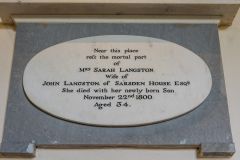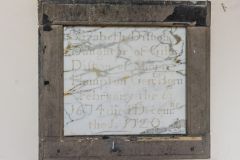
The Churchill and Sarsden Heritage Centre is a fascinating local history museum housed in the 14th-century chancel of Churchill Old Church, the only surviving part of the village's medieval parish church. In this case, the Heritage Centre building is as interesting as the exhibits it holds.
Churchill Old Church
There was almost certainly a Saxon church in the Oxfordshire village of Churchill, but the first written record of a church comes from 1170 when the lord of the manor Henry de Noers granted the advowson to St Frideswide's Priory in Oxford.
That 12th-century church was rebuilt in the early 14th century by the de Nowers family (note the evolving spelling of the family name). That church was finished by 1348, the same year that the Black Death arrived in England.
The church stood at the centre of the medieval village of Churchill. Over time the focus of the village shifted to the top of the hill, leaving the church on the edge of the village.

By the early decades of the 19th century, the medieval building was in a poor state of repair. JH Langston, who held the patronage of Sarsden and Churchill, petitioned the Bishop of Oxford for permission to build a new church at the top of the hill. The Bishop granted permission and construction began on the present All Saints Church in 1826.
The Old Church was pulled down, but the chancel was left to serve as a mortuary chapel for the village cemetery. Several memorials from the Old Church were retained, including a wall monument to Elizabeth Bourne, the daughter of Sir Edmund Horne of Sarsden House, who died in 1599. Elizabeth was married to Sir John Bourne, who served as Secretary of State under Queen Mary I.
The Old Church was restored in 1868 by Elizabeth Barter, the wife of Rev Charles Barter, the vicar of Churchill and rector of Sarsden. As part of the restoration, some monuments were removed from the church and placed in the graveyard.

Outside the church door is an octagonal stone that probably served as the base of a medieval font. You can still see outlines of the rest of the medieval church in the surrounding graveyard. Another feature in the graveyard is a 17th-century monumental arch that once gave access to the parsonage garden.
The church was finally made redundant in 1895 and most of its furnishings were sold off. The church is now cared for by the Churchill Old Church Preservation Society, a registered charity.
Exhibits
We mentioned the 1599 Elizabeth Bourne memorial above. Other historic monuments to survive include that of Sir John Walter of Sarsden, MP, who died in 1722. The florid epitaph describes him in these words:
He distinguished himself
By many valuable Qualitys
Many Private and sociable Virtues
which gain'd him
Affection from his own Family
Esteem among his Acquaintance
Reputation, and Interest in his Country
He convers'd with an Openness of ming & Freedom of Speech
and acted by the strictest rules of Justice and Honour
He was
A kind and obliging Husband,
An entertaining Companion,
a Sincere and faithfull Friend,
Hospitable Generous Publick Spirited
And Steady in adhering to the English Constitution
In Church and State

Then there is a tablet commemorating Anne Walters, who gave £600 to establish a school 'For the liberal education of poor girls' in 1716.
On the south wall is a poignant memorial tablet to Mrs Sarah Langston who died in childbirth in 1800. She was the wife of JH Langston, who paid for the new church. There is a small plaque commemorating Elizabeth Difton (d 1720) and a memorial to Gyles Harris (d 1647).
Crime and Punishment
At the east end of the church is an exhibit on crime and punishment in Churchill and Sarsden. There are two parts to the exhibit; Crime and Criminals, and Constables and Courts. Crime and Criminals looks at local offenders and the sorts of crimes they were tried for. The most common crimes were typical of a rural area - theft, assault, and poaching.
Constables and Courts looks at law enforcement, from local constabularies to the magistrates who tried cases. In most cases, the magistrates were simply prominent local landowners.
Here you will find a pair of 19th-century manacles used by the local police constables.
There is also a four-volume set of Richard Burn's legal manual used by local magistrates, who often had little formal training. The books are annotated with handwritten notes by a Gloucestershire magistrate as new laws were passed or existing laws changed.
Occupying the centre of the church is the old parish bier, used to carry coffins to the graveyard for burial.

William Smith
There is also a very good display on the life of William Smith, known as the 'Father of British Geology'. Smith was born in Churchill on 23 March 1769 and died in Northampton on 28 August 1839. His father was the local blacksmith and he was educated in the village school. He became interested in the echinoid fossils known as 'poundstones' that he found in the surrounding fields.
That sparked a lifelong interest in geology. Smith was one of the first to realise that rock layers appeared in predictable patterns and that fossils in the rocks could be used to establish a chronology of rock layers. In 1815 he published a hand-coloured geological map of Britain laying out the timeline of rock layers. Smith helped establish the Rotunda Museum in Scarborough, where you can see many of his fossils on display.
A monument to William Smith stands at the top of Hastings Hill, a short stroll from the Heritage Centre.
Warren Hastings
The Heritage Centre also looks at the life and career of Warren Hastings (1732-1818), who was born just a stone's throw away in Hastings House, on Hastings Hill (look for the brown plaque). Hastings joined the East India Company and rose through the ranks to become the Governor-General of India in 1773.
In 1787 Hastings was impeached for corruption. In a trial lasting seven years, he was found innocent of all charges. He lived the last years of his life at nearby Daylesford, where he rebuilt the church. He died in 1818 and is buried in the churchyard there.
The Heritage Centre also highlights the life of JH Langston, who inherited Sarsden House at the age of 16. He called in the famous landscape garden designer Humphry Repton to lay out the grounds of Sarsden House and later had his son George Repton rebuild the house. Aside from building All Saints Church at his own expense, Langston served as an MP and High Sheriff of Oxfordshire. He built the Chipping Norton Town Hall, Milton under Wychwood Church, and brought the railway to Chipping Norton.

Getting There
The Churchill and Sarsden Heritage Centre is located in the middle of the village cemetery on Hastings Hill, just off the B4450. Thee is usually a signboard on the traffic island at the top of Hastings Hil where it meets the B4450 when the centre is open.
You will find the gate into the cemetery at the edge of the village. There is no paved pathway through the cemetery so you will want to wear good waterproof footwear in wet weather.
We had a wonderful visit to the Heritage Centre, despite a sudden shower as we were preparing to leave. We were welcomed by a very friendly volunteer who told us about the history of the Old Church and was happy to answer any questions we might have.
About Churchill and Sarsden Heritage Centre
Address: Hastings Hill,
Churchill,
Cotswolds,
Oxfordshire,
England, OX7 6NA
Attraction Type: Museum
Location: In the village cemetery on Hastings Hill, off the B4450.
Website: Churchill and Sarsden Heritage Centre
Email: churchillheritage@gmail.com
Location
map
OS: SP279245
Photo Credit: David Ross and Britain Express
HERITAGE
 We've 'tagged' this attraction information to help you find related historic attractions and learn more about major time periods mentioned.
We've 'tagged' this attraction information to help you find related historic attractions and learn more about major time periods mentioned.
Find other attractions tagged with:
NEARBY HISTORIC ATTRACTIONS
Heritage Rated from 1- 5 (low to exceptional) on historic interest
Churchill, All Saints Church - 0.4 miles (Historic Church) ![]()
Salford, St Mary's Church - 2.2 miles (Historic Church) ![]()
Bledington, St Leonards - 2.5 miles (Historic Church) ![]()
Adlestrop, St Mary Magdalene - 2.6 miles (Historic Church) ![]()
Chipping Norton, St Mary's Church - 2.7 miles (Historic Church) ![]()
Lower Oddington, St Nicholas Church - 2.7 miles (Historic Church) ![]()
Chastleton House - 3.4 miles (Historic House) ![]()
Little Rollright, St Philip - 3.5 miles (Historic Church) ![]()
Nearest Holiday Cottages to Churchill and Sarsden Heritage Centre:
Chipping Norton, Oxfordshire
Sleeps: 4
Stay from: £599 - 2427
More self catering near Churchill and Sarsden Heritage Centre












